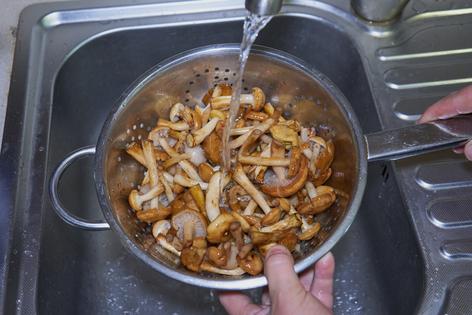5 foods you’re probably cleaning wrong
Published in Health & Fitness
An essential part of the cooking process is prepping your ingredients. Most of us probably don’t think too much about how we wash fruits, veggies and other foods, but as with most things, there’s a right way and there’s a wrong way. Sometimes, incorrect cleaning means a little grit in your salad, but in other instances it can be the difference between a memorable meal and a food-safety nightmare. Here are five foods that are frequently washed in a way that’s less than ideal, and the proper way to get them cleaned and ready for your next great feast.
1. Mushrooms
If you dread or even avoid cooking mushrooms, because it takes so long to clean each one with a damp paper towel, we have good news. It’s actually totally OK to wash your favorite fungi. Mushrooms are porous, so it’s best not to soak them, but a quick rinse under cold, running water is perfectly fine and won’t make them waterlogged.
2. Chicken
There’s a long-held belief that washing raw chicken is crucial. However, this is the last thing you should do. Yes, raw chicken can contain bacteria, but washing it just risks spreading that bacteria to kitchen surfaces, utensils and even other food. Instead, use a separate cutting board and utensils for raw chicken, wash your hands with warm soapy water before and after you handle it, and use a thermometer to check that your bird is fully cooked — that’s what's going to kill any bacteria. The FDA recommends an internal temperature of 165 F, whether you’re roasting a whole chicken or cooking parts.
3. Greens
Unlike bagged lettuce, greens bought in bunches require thorough washing. The leaves of hearty greens—think spinach, collards, kale and chard — have a knack for trapping dirt, so rinsing really won’t cut it. Swish the greens in a bowl of cold water to remove any dirt — it will fall to the bottom—and soak especially dirty greens for five minutes. Next, lift out the greens and dry them with towels or a salad spinner.
4. Berries
While we love advance prep, rule No. 1 for washing berries is to wait until you’re ready to eat them. Why? Moisture leads to mold and spoilage, so it’s best to store berries dry. If you must wash berries ahead, be sure to thoroughly dry them on a paper-towel-lined baking sheet before refrigerating. As for the actual washing, remember that berries are delicate. Strawberries are sturdy enough to be rinsed in a colander, but blackberries, raspberries and blueberries require extra care. Place them in a colander, dip it in cold water and gently swish the berries to remove any dirt without crushing them.
5. Leeks
When it comes to trapping dirt, there may be no worse offender than leeks. These versatile members of the allium family are grown with soil piled around them, which means they need serious cleaning. Start by trimming the roots and dark green tops, then cut each leek lengthwise in half. If you’re cooking leeks in larger pieces, hold each leek half under cold running water, riffling the layers like a deck of cards to help remove all the dirt. For smaller pieces, cut or chop your leeks then swish them in a bowl of cold water before lifting them out and leaving the dirt behind.
(EatingWell is a magazine and website devoted to healthy eating as a way of life. Online at www.eatingwell.com.)
©2024 Dotdash Meredith. All rights reserved. Used with permission. Distributed by Tribune Content Agency, LLC.







Comments